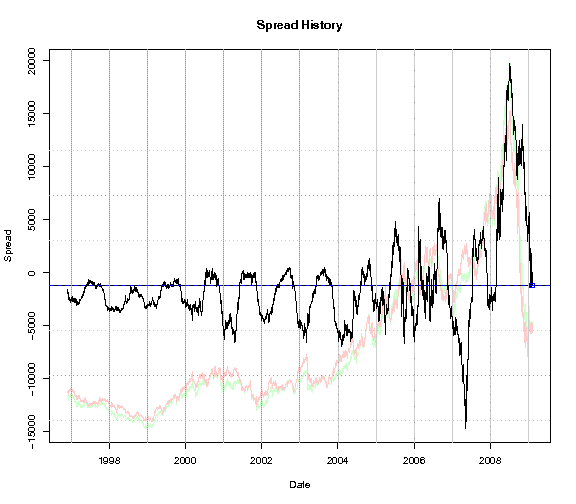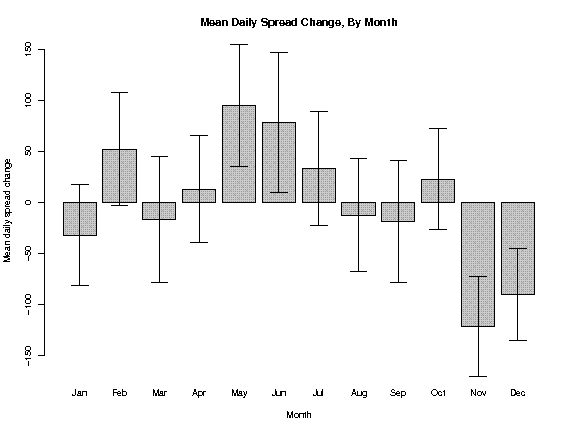Finding
Seasonal Spreads
Paul
Teetor
Many spreads show seasonality -- that is, regular patterns from
year-to-year -- and can be a valuable source of profits and
diversification. Seasonal spreads, however,
seem
to get little attention from the quantitative community.
I’d like to remedy that by showing one way to identify
seasonal
spreads using legitimate statistical techniques. I'll start
with
an example of a seasonal spread: crude oil versus
gasoline.
Example: Crude oil versus
gasoline
Here is a chart of the spread between crude oil futures (CL) and
gasoline futures (RB) from 1997 to the present, covering about 12 years
of history.
If you look closely, it appears that the spread often falls during
Winter, then rises from Spring into Summer. But how can we be
sure? Perhaps we are just imagining the pattern, based on a
few
examples. And what are the actual months when it falls and
rises?
Here is how we can test for a seasonal pattern.
- Compute the daily change in
the spread, st,
giving us one Δst
value for every day of the spread’s history.
- For each day, group the
day’s change according to the month
of that day.
- Compute the average change
for each monthly group.
That will give a table such as this, with one mean change (µ)
for
every month, taken over all the years of spread history.
| |
Jan |
Feb |
Mar |
Apr |
May |
Jun |
Jul |
Aug |
Sep |
Oct |
Nov |
Dec |
| Mean change |
-31.97 |
52.15 |
-16.74 |
12.98 |
94.73 |
78.16 |
33.08 |
-12.39 |
-18.88 |
22.77 |
-121.50 |
-90.37 |
(These averages are in dollars per day.)
The monthly averages suggest trades: January is a down month,
on
average,
so sell the spread during January. Likewise, February is an
up
month, on average, so buy the spread during February.
Those trades would be very naïve, however. A
statistician
would ask an important question before risking real money:
What
is probability that the true mean is actually positive or
negative? The averages for April and August are pretty small
(12.98 and -12.9), for example. Maybe our sample is too
small,
and these averages are not representative. How realistic are
these numbers?
The solution is to form confidence intervals for each monthly
mean. This barchart shows the mean change taken from the
table
above, then superimposes the confidence intervals over each bar, giving
us a composite view of the monthly averages.
Consider the bar for January. Yes, the mean change is
negative,
but the confidence interval crosses over into positive
territory.
Statistically speaking, we cannot be
confident that the true mean is
negative. It could
be zero or even positive, so selling
the
spread during January could be unwise. In fact, the
confidence
interval includes zero for most months, and we cannot be confident
there is any seasonal trend in those months, either positive or
negative.
The confidence interval for May, however, is completely
positive.
We can be confident that the average historical daily change in May is
positive. In fact, May and June are clearly
“up”
months, and November and December are clearly
“down”
months. Now we have our seasonal trade for the CL/RB spread:
- Buy the spread on May
1. Close the position on Jul 1.
- Short the spread on Nov
1. Close the position on Jan 1.
Finding Seasonal Spreads
Automatically: ANOVA
This analysis would be quite tedious if we performed it manually for
every spread we know. Fortunately, we can use ANOVA to
automatically identify seasonality in spreads.
ANOVA stands for analysis of variance.
ANOVA compares groups of
observations, such as our month-wise groups of spread
changes. It
reports the probability that one or more groups have significantly
different means, compared with the other groups.
The ANOVA report includes a probability
value, or simply p-value,
which
is the probability that all the means are identical. So a
small
p-value
means one or more
groups are probably not the same. In
the CL/RB example, above, my computer reports a p-value
of less than
0.0001, so the probability that all months have the same average change
is less than 0.01%.
My computer runs a weekly batch job which computes the ANOVA p-value
for every spread in my database. If the p-value
is 0.05 or less,
I know there is a 95% probability that the spread changes are
significantly different from month-to-month; in other words, the spread
exhibits a seasonal pattern. In those cases, the batch job
saves
the p-value
in the
database. Later, I run a report to select the
spreads with the best (i.e., smallest) p-values.
Those are my
candidates for seasonal trades.
The computer tests every combination of stocks and futures, so it
occasionally reports a bizarre seasonal spread. It recently
discovered that the spread between British Pound futures (BP) and Live
Cattle (LC) shows seasonality at a confidence level of 96% or
better. Would I trade the BP/LC spread? Of course
not,
because I cannot discern the economic logic of the trade.
Limitations
This analysis is not an automated trading system and has important
limitations.
- The analysis does not make a
prediction. It only reports
the past pattern. When you trade that pattern, you are
assuming
this year is like other years.
- The basic ANOVA analysis
only reports that some months are
different, not which months are different. The trader must
look
at monthly pattern to choose the right time for the trade.
- The trade decision must also
incorporate the current market
conditions. For example, if the history recommends buying but
the
spread is already quite high, the trade could be unwise.
- This analysis looks at
monthly patterns. The seasonal
patterns at other boundaries might be more distinct and, hence, better
trades.
Next Steps
We can augment this analysis by computing the spread’s Z
score,
then selecting trades which show harmony between their historical
pattern and current status. We can also improve the analysis
by
incorporating a seasonal version of the Ornstein-Uhlenbeck
formula,
letting us predict the time-to-profit. I hope to cover these
subjects in the future.
Additional Details For the
Curious
The data for the CL/RB spread, above, was purchased from Commodity
Systems Inc. (CSI), using their
Perpetual Contact data. This
example was as of Feb 5, 2009.
When I say “long the
CL/RB spread”, I mean buy CL and
sell RB. Likewise, “short the spread”
means sell CL
and buy RB.
I compute the hedge ratios for
my spreads using ordinary least
squares, as suggested in Ernie
Chan's book. The ratio for
the
CL/RB spread, above, was 1.1376 CL contracts for each RB contract.
Notice that I compute the
spread change,
not the spread
return.
Quants usually
study price returns, but that won’t
work with spreads because the spread can be zero, giving an undefined
return. The daily change follows a similar bell-shaped
distribution, so it’s a reasonable object for study.
I monitor about 115 stocks and
futures, so I have about 6,670
spreads to be tested weekly. A typical recent run found that
over
270 spreads that exhibit some seasonality, or about 4% of those
tested. The ANOVA batch job requires about 2-1/2 hours to
complete on my computer. The software is written in a
combination
of Perl
and R,
the free statistical software
system, running under
Linux.
References
The original and still-the-best book on seasonality is Seasonality:
Systems, Strategies, and Signals,
by Jake Bernstein. Some
of the
ideas in this analysis were inspired by Bernstein’s book.
Most good textbooks on
statistics discuss ANOVA. There is an
article
on
Wikipedia, but it is not a
tutorial.
Any decent software for
statistics includes the ANOVA
analysis. That includes R
and Octave,
which
are both free.


